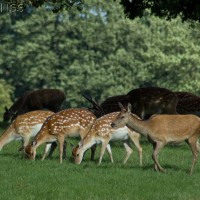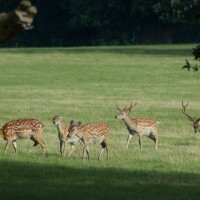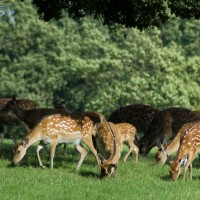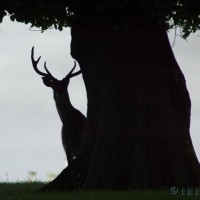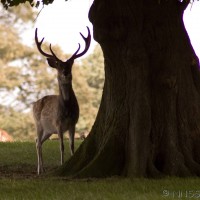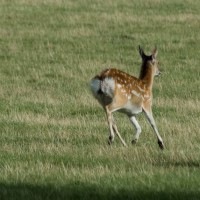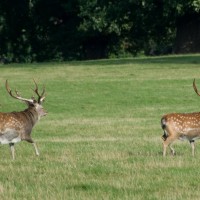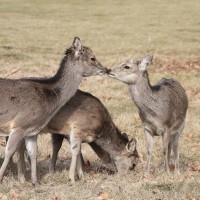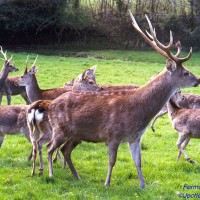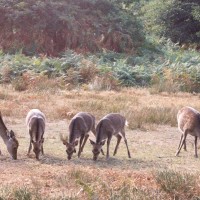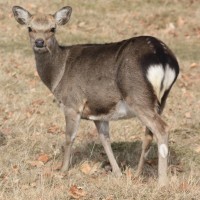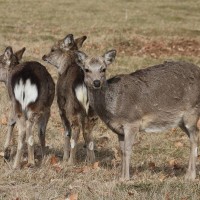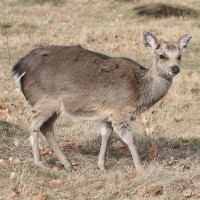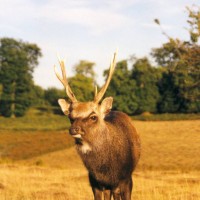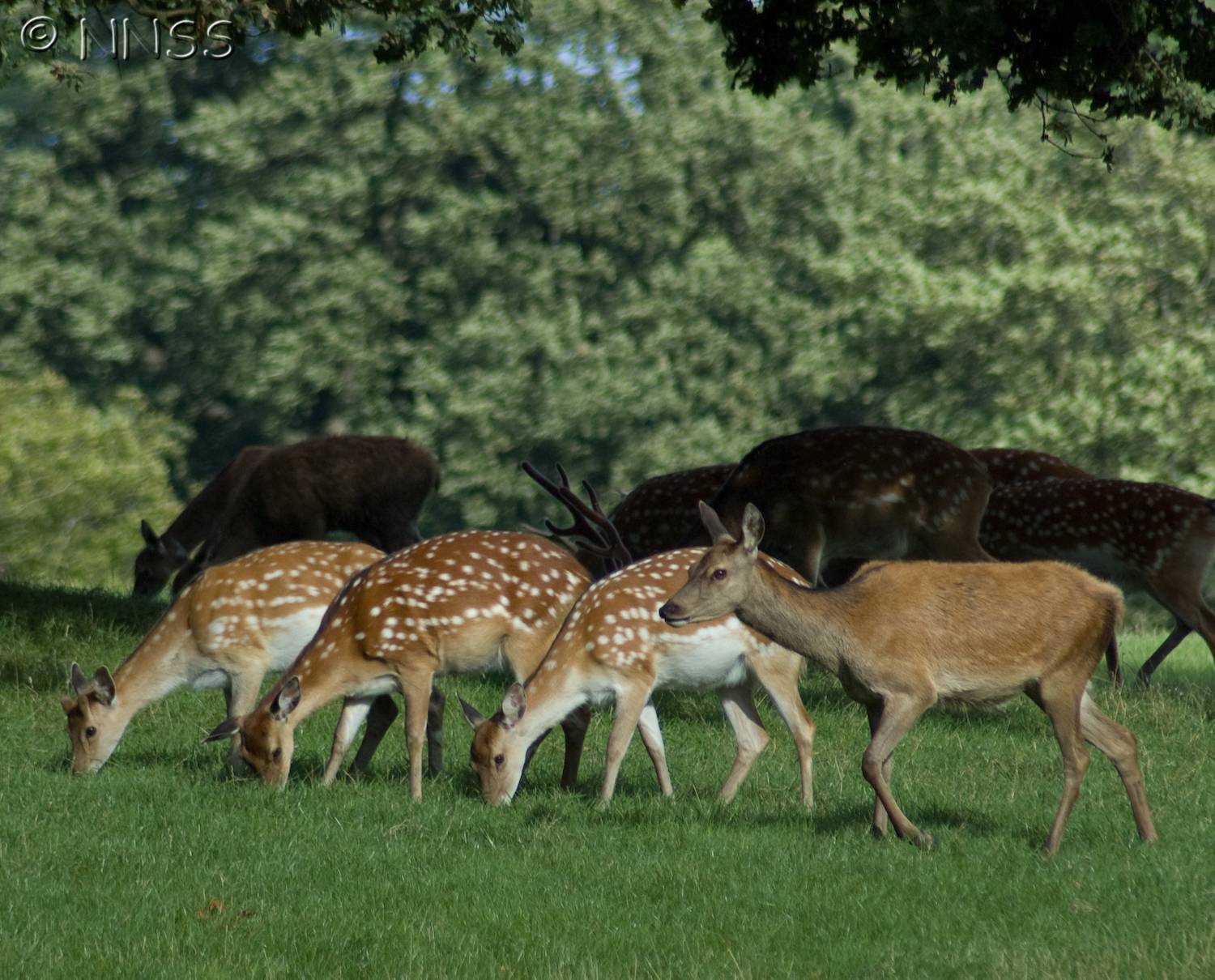
Sika Deer - Cervus nippon
Expand and collapse the sections below by clicking on the title or + / - icons.
Short description of Cervus nippon, Sika Deer
Sika deer are similar to red deer but smaller. Sika deer are mainly reddish- or yellowish-brown, with a dark dorsal stripe (in summer surrounded by white spotting). There is a large, white, heart-shaped patch, edged with black, on the rear end and a thin, dark line down the white tail.
Impact summary: Cervus nippon, Sika Deer
Sika deer hybridise with red deer and there are likely to be only a few pure red or sika deer remaining in GB. They cause serious damage in some regions to crops, forestry, reedbeds, saltmarshes, bogs and heathland through grazing and trampling.
Habitat summary: Cervus nippon, Sika Deer
Sika deer occupy a broad range of habitats in GB, including mature broad-leaved woodland, heathland and bog, marshland, saltmarsh and offshore islands.
Overview table
| Environment | Terrestrial |
|---|---|
| Species status | Non-Native |
| Native range | Fujian, Guangdong, Jiangsu, Shandong, Shanghai, Zhejiang, Hokkaido, Honshu, Kyushu, Shikoku, Primorye |
| Functional type | Herbivore |
| Status in England | Non-Native |
| Status in Scotland | Non-Native |
| Status in Wales | Non-Native |
| Location of first record | Waddesden Park |
| Date of first record | 1874 |
Origin
The native range lies in eastern Asia, from south-eastern Siberia to eastern China, Japan, Taiwan and southwards through Manchuria and Korea.
First Record
The introduction of Sika deer to an estate at Tulliallan in Fife in around 1870 may have been the first in GB, and was followed by many similar introductions in England, Wales and Scotland over subsequent decades.
Pathway and Method
Sika deer were first brought to London Zoo in 1860 and became popular as an ornamental animal for deer parks on large estates. Many deer subsequently escaped or wandered from deer parks and some were deliberately introduced into the wild.
Species Status
Sika deer have become firmly established in many areas of GB and are increasing and spreading their range. They have a similar status in Ireland, where introductions began in 1860. Other introduced populations exist in several areas of western Europe, in New Zealand and in several states of the USA.
Dispersal Mechanisms
Sika generally show relatively small movements between summer and winter. In a continuous optimal habitat, sika show a steady expansion in range, estimated in GB at 3–5 km per year. In areas with fragmented habitats, dispersal is characterised by long periods of no movements, followed by a sudden and rapid eruption from the source. Young males disperse before females.
Reproduction
Rutting season in Europe is September–November. Reproductive rates are extremely high: conception rate is 80–90% and adult pregnancy rate 85–100%. Gestation is 210–246 days and calves (one, occasionally two) are born in May–June. Most hinds breed successfully for the first time as yearlings.
Known Predators/Herbivores
A high neonatal mortality (survival rate in December 40–50%) is largely due, in Europe, to predation of calves by red foxes.
Resistant Stages
None known.
Habitat Occupied in GB
Sika deer occupy a broad range of habitats in GB, including mature broad-leaved woodland, heathland and bog, marshland, saltmarsh, and offshore islands.
Sika deer have been introduced into many areas of the world: New Zealand, South Africa, Morocco, Australia, Papua New Guinea, North America. In Europe feral populations are present in GB, Ireland, Denmark, France, Austria, Switzerland, Poland, the Czech Republic and Russia. In many European countries Sika deer are increasing and expanding in distribution (e.g. by 5.3% per year in mainland GB during 1972–2002).
Environmental Impact
Sika deer cause tree damage due to ring barking (especially in hard winters), browsing, trampling and antler rubbing, erosion due to creation of trails, and degradation of water quality in creeks and streams. Mature trees may suffer additional damage through bole-scoring (characteristic of this species). In open heathland and wetland, sika deer can cause significant change in vegetation structure and species composition of both plants and animals. Hybrids with the native, congeneric red deer are fertile, and further hybridisation or back-crossing to either parental type is threatening the genetic integrity of both red deer and sika deer.
Health and Social Impact
In Eastern Europe, sika deer are a vector of an Asiatic blood-sucking gastro-intestinal nematode Asworthius sidemi, which affects bison, roe deer, red deer and potentially farm livestock. Both bovine and avian TB have been recorded in captive and wild sika populations. Sika deer are responsible for a number of road traffic accidents.
Economic Impact
Sika deer are a serious forest pest, causing significant damage to broad-leaved and conifer plantations.
Identification
Horwood, M.T. & Masters, E.H. (1970) Sika Deer. British Deer Society, Reading.
Putman, R.J. (2000) Sika Deer. British Deer SocietyMammal Society.
Biology, ecology, spread, vectors
Chadwick, A.H., Ratcliffe, P.R. & Abernethy, K. (1996) Sika deer in Scotland: density, population size, habitat use and fertility – some comparisons with red deer. Scottish Forestry, 50, 8–16.
Mann, J.C.E. & Putman, R.J. (1989) Habitat use and activity patterns of British sika deer (Cervus nippon Temminck) in contrasting environments. Acta Theriologica, 34, 83–96.
Mann, J.C.E. & Putman, R.J. (1989) Diet of British sika deer (Cervus nippon Temminck) in contrasting environments. Acta Theriologica, 34, 97–110.
Putman, R.J. & Clifton-Bligh, J.R. (1997) Age-related bodyweight, density and fecundity in a south Dorset sika population (Cervus nippon), 1985–93. Journal of Natural History, 31, 649–660 .
Putman, R.J. & Mann, J.C.E. (1990) Social organisation and behaviour of British sika deer in contrasting environments. Deer, 8, 90–94.
Ratcliffe, P.R. (1987) Distribution and current status of sika deer, Cervus nippon, in Great Britain. Mammal Review, 17, 39–58.
Swanson, G.M. & Putman, R. (2009) Sika deer in the British Isles. In: McCullough, D.R., Takatsuki, S. & Kaji, K. (eds), Sika Deer: biology and management of native and introduced populations, pp 595–614. Springer, Tokyo.
Management and impact
Akashi, N., Nakashizuka, T. (1999) Effects of bark-stripping by Sika deer (Cervus nippon) on population dynamics of a mixed forest in Japan. Forest Ecology and Management, 113, 75–82.
Diaz, A., Pinn, E.H. & Hannaford, J. (2005) Ecological impacts of sika deer on Poole Harbour saltmarshes. In The ecology of Poole Harbour (eds J. Humphreys & V. May), pp. 175–188. Elsevier, Amsterdam.
Gill, R.M.A. (1992) A review of damage by mammals in north temperate forest: 1. Deer. Forestry, 65, 145–169.
Gill, R.M.A., Webber, J. & Peace, A. (2000) The Economic Implications of Deer Damage – a review of current evidence. Final Report for The Deer Commission for Scotland, 53 pp.
Goodman, S., Barton, N., Swanson, G., Abernethy, K. & Pemberton, J. (1999) Introgression through rare hybridization: a genetic study of a hybrid zone between red and sika deer (genus Cervus) in Argyll, Scotland. Genetics, 152, 355–371.
Harrington, R. (1982) The hybridisation of red deer (Cervus elaphus L. 1758) and Japanese sika deer (C. nippon Temminck, 1838). International Congress of Game Biologists, 14, 559–571.
Lowe, V.P.W. & Gardiner, A.S. (1975) Hybridisation between red deer and sika deer, with reference to stocks in north-west England. Journal of Zoology (London), 177, 553–66.
Pemberton, J., Swanson, G., Barton, N., Livingstone, S. & Senn, H. (2006) Hybridisation between red and sika deer in Scotland. Deer, 13, 22–26.
Putman, R.J. (1997) Chemical and immunological methods in the control of reproduction in deer and other wildlife: potential for population control and welfare implications. Technical Bulletin of the Royal Society for the Prevention of Cruelty to Animals, Horsham, 50 pp.
Putman, R.J. (1997) Deer and road traffic accidents: options for management. Journal of Environmental Management, 51, 43–57.
Putman, R.J. & Hunt, E.J. (1994) Patterns of hybridisation and introgression between red and sika deer in different populations of the North of Scotland and Argyll. Deer, 9, 104–110.
Putman, R.J. & Moore, N.P. (1998) Impact of deer in lowland Britain on agriculture, forestry and conservation habitats. Mammal Review, 28, 141–164.
Ward, A.I. (2005) Expanding ranges of wild and feral deer in Great Britain. Mammal Review, 35, 165–173.
Wilson, C. (2003) Current and future deer management options. Report on behalf of Defra European Wildlife Division. full text
General
Long, J.L. (2003) Introduced mammals of the world: their history, distribution, and influence. CABI & CSIRO Publishing, Collingwood, Victoria.
McCullough, D.R., Takatsuki, S. & Kaji, K. (2009) Sika Deer: biology and management of native and introduced populations. Springer, Tokyo.
Spotted this species?
Distribution map
View the Distribution map for Sika Deer, Cervus nippon from NBN Atlas
ID Sheet
ID Sheet for Cervus nippon . See a full list of non-native species ID Sheets.
Risk assessment
Risk assessment for Cervus nippon. See a full list of non-native species Risk assessments.
Listen to Sika Deer

